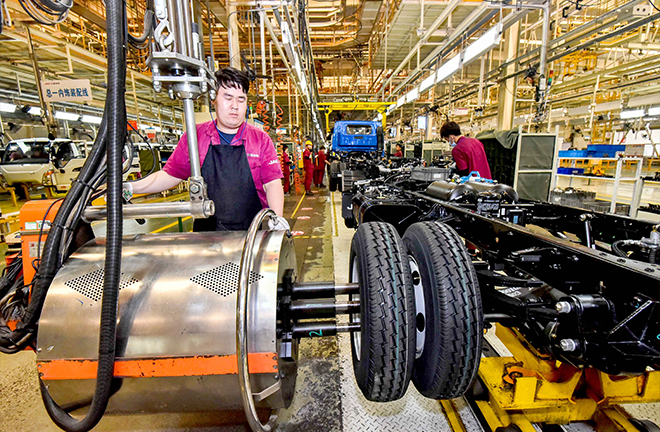Chinese manufacturing: risks and benefits coexist

A worker in the car manufacturing assembly line PHOTO: Sen Lin/CNSphoto
In the face of new contradictions and challenges brought about by changes in environments at home and abroad, a new development paradigm is needed for the manufacturing industry in China so as to foster its high-quality development.
Global industrial chain
Generally speaking, the existing production chain is the result of the division of labor and cooperation among countries in the process of economic globalization. As comparative advantages between countries have evolved, the industrial chain is bound to be adjusted and restructured.
Overall, the current industrial chain is restructured in the following ways: the first is that international trade accounted for a declining proportion in the total output. In the process of economic globalization, the ratio of international trade in total output had grown rapidly. Affected by the international financial crisis in 2008 and the trade protectionism advocated by the Western countries in recent years, as well as today’s raging COVID-19 pandemic, the world economy is clouded by the trends of “anti-globalization.” Although the volume of international trade in sheer number has increased, its proportion in the total output is declining year by year.
Second, the international trade structure has changed. The proportion of tangible goods trade including manufacturing trade has been dropping for years, while the proportion of trade in services has increased, which has grown at a rate 60% higher than tangible goods trade in the past decade. This trend is expected to continue into the future. As the technology of artificial intelligence is widely applied, the prioritized factors for multi-national enterprises will mainly depend on market size, technical capacity, public facilities, and institutional environment. This makes it difficult for countries with relative comparative advantages in labor to capitalize on their competitive advantages.
Third, impacted by the changes in the international trade environment and the pandemic, the transaction cost between multi-national corporations has greatly increased. As a result, the industrial chains in those manufacturing industries with many links of labor division such as the vehicle and electronic sectors were shortened.
Severe external environment
Compared with the service industry, the manufacturing industry can not only spur investment, but also improve the potential for economic growth through capital accumulation. However, the global industrial chain restructuring will bring a series of challenges to the manufacturing industry in China. Affected by the pandemic, the global economy is facing the worst recession since World War II, with the unemployment rate of many countries rising significantly. The economic recovery is facing great uncertainty, which means a severe external environment for China’s manufacturing industry.
As China progresses into the late stage of industrialization, the cost of such factors of production as land and labor force rises. In addition, there are increasing resource and environmental constraints. The factor dividend, which was once the chief driver of economic growth, is now unsustainable.
The restructuring of the industrial chain also led to reallocation of manufacturing industries on a global scale. On one hand, developed countries represented by the US expedited the technology-intensive industries’ pace of backflow into their own native land. On the other hand, other economies including Southeast Asian countries scrambled to undertake the transfer of labor-intensive industries into their countries. Under the coupled influence of the above factors, the proportion of Chinese manufacturing in GDP dropped from over 32% in 2007 to about 26% in 2020. Trends of de-industrialization have appeared in a premature and excessively rapid way.
In view of this, risks and benefits coexist. In bringing about challenges, the industrial chain restructuring gives new impetus to Chinese manufacturing. As a world-famous center for manufacturing, China has the ability to make breakthroughs in core technologies. At the same time, the bleak foreign market means that those enterprises (the old chain leaders) have a weaker control of the global value chain. Given this, Chinese manufacturing enterprises will shift their focus onto the domestic super-market with more than 1.4 billion population and more than 0.4 billion middle-income people. By creating its own unique brands and establishing native marketing channels, China can steadily advance towards the global medium- and high-end industrial and value chains.
Liu Ruixiang is a research fellow from the Yangtze Industrial Economic Institute at Nanjing University.
Edited by BAI LE
